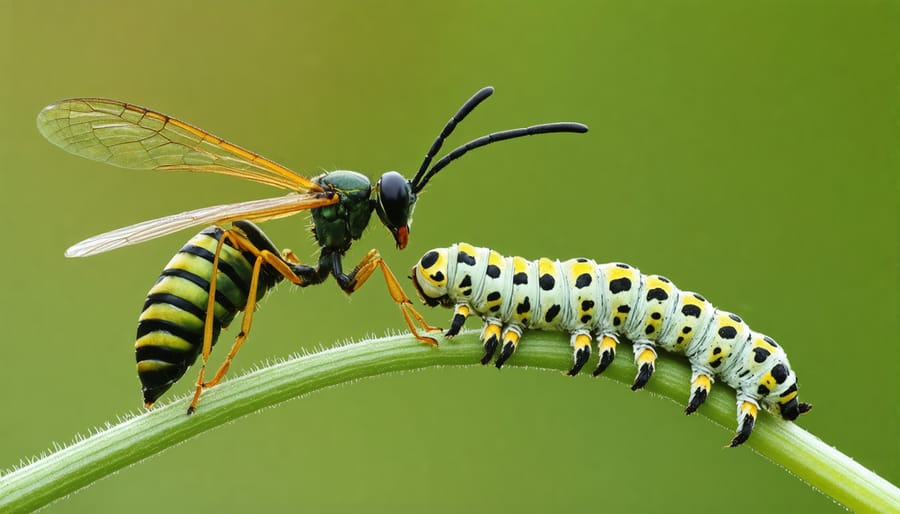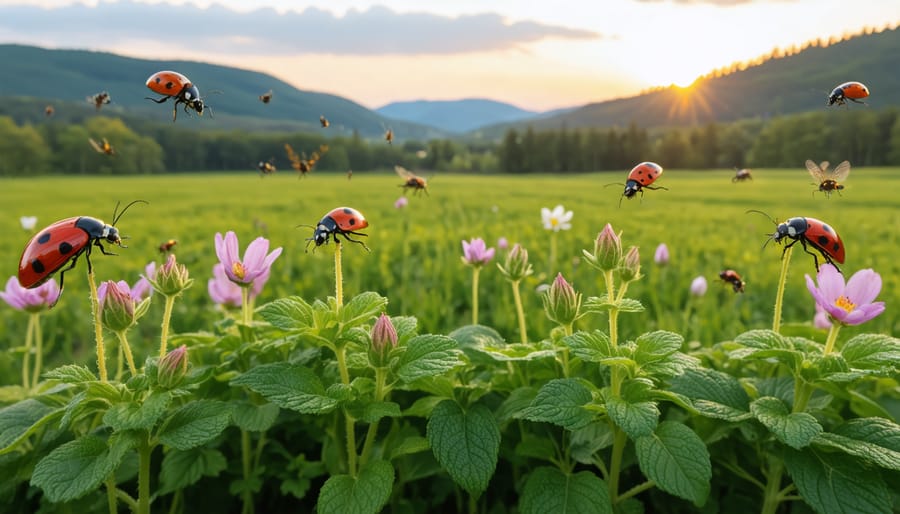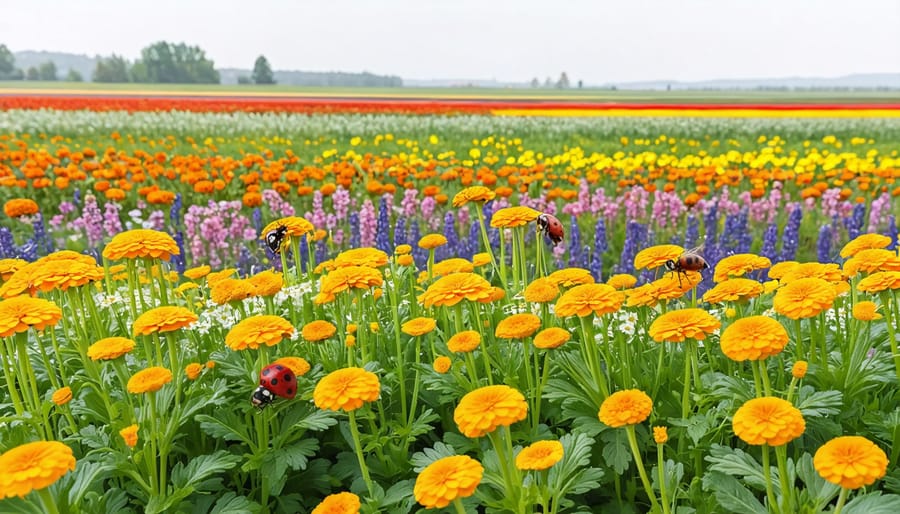Deploy ladybugs and lacewings strategically during spring emergence to combat aphid infestations, releasing them at dusk when dew formation helps keep them in your fields. Establish permanent beetle banks along field margins by planting bunch grasses and flowering perennials, creating year-round habitat for ground beetles that devour crop-damaging insects. Partner parasitic wasps with trap crops like sweet alyssum to create a sustainable defense system winning the pest battle naturally while protecting pollinators. Canadian farmers who implement these biological control strategies report up to 60% reduction in pest damage without chemical interventions.
These proven methods, validated through extensive field trials across Alberta’s diverse growing regions, demonstrate how beneficial insects become permanent allies in sustainable agriculture. By maintaining healthy populations of these natural predators, farms create resilient ecosystems that suppress pest outbreaks naturally, reducing both operational costs and environmental impact while improving crop yields.
Nature’s Most Effective Pest Controllers
Lady Beetles: More Than Just Ladybugs
When most folks think of lady beetles, they picture the familiar red and black spotted ladybugs in their gardens. However, these helpful insects are far more diverse and powerful allies in pest control than many realize. Here in Alberta, we’re fortunate to have several native species that work tirelessly to protect our crops.
A single lady beetle can consume up to 5,000 aphids during its lifetime, making them incredibly efficient pest controllers. They’re particularly effective against soft-bodied insects that commonly plague canola, wheat, and vegetable crops across the prairies. What’s even better is that they’ll stick around as long as there’s food available, providing lasting protection throughout the growing season.
Local farmer Sarah Thompson from Leduc County shares, “Since we started encouraging lady beetles in our fields, we’ve cut our pesticide use by nearly 40%. They’re especially helpful in our greenhouse operations during the winter months.”
To attract and retain lady beetles, consider planting companion flowers like dill, yarrow, and dandelions near your crops. These plants provide necessary pollen when pest populations are low. Creating overwintering sites with brush piles or leaving some plant debris in field margins can also help maintain healthy lady beetle populations year after year.
Remember that lady beetles come in various colours, from orange to pink to black, and all of them are beneficial. Protecting these natural allies means avoiding broad-spectrum insecticides that could harm them along with the pests they control.

Parasitic Wasps: The Microscopic Warriors
Parasitic wasps are nature’s most efficient pest controllers, playing a crucial role in protecting crops across Alberta’s diverse agricultural landscape. These tiny but mighty insects, most measuring just 1-2 millimetres in length, target specific pest species that can devastate crops.
One of our local heroes is the Trichogramma wasp, which specifically targets the eggs of moth pests that damage canola crops. These microscopic warriors lay their own eggs inside pest eggs, effectively stopping crop damage before it begins. A single female can eliminate up to 100 pest eggs during her two-week lifespan.
Braconid wasps, another valuable group, are particularly effective against tomato hornworms and cabbage worms. When these wasps parasitize a caterpillar, they leave behind small white cocoons on the pest’s body – a sign that natural pest control is actively working in your fields.
Here in Alberta, many farmers have successfully integrated parasitic wasps into their pest management strategies. Jim Thompson, a third-generation farmer near Red Deer, reported a 60% reduction in caterpillar damage after introducing parasitic wasps to his vegetable crops last season.
To attract and maintain parasitic wasp populations, consider planting flowering herbs like dill and cilantro along field edges. These plants provide nectar for adult wasps while they search for pest hosts. Remember that these beneficial insects are sensitive to chemical pesticides, so minimal chemical intervention allows their populations to thrive naturally.

Implementing Biological Control on Your Farm
Creating the Perfect Habitat
Creating a welcoming environment for beneficial insects is crucial for successful biological control. Here in Alberta, we’ve found that a few key strategies can make all the difference in attracting and retaining these helpful creatures on your farm.
Start by establishing diverse plantings throughout your property. Include flowering plants that bloom at different times throughout the growing season, particularly early spring and late fall when food sources might be scarce. Native plants like yarrow, goldenrod, and asters are excellent choices that provide nectar and pollen while requiring minimal maintenance.
Create windbreaks and shelter belts using a mix of trees and shrubs. These areas serve as overwintering sites and protect beneficial insects from harsh prairie winds. Consider leaving some areas of your land unmowed or minimally disturbed to provide natural habitat zones.
Water sources are essential but often overlooked. Simple solutions like shallow dishes filled with pebbles and water or small irrigation drip lines can provide the moisture these insects need. During our dry Alberta summers, maintaining consistent water sources becomes especially important.
Soil management plays a vital role in habitat creation. Maintain healthy soil through reduced tillage practices and organic matter incorporation. Many beneficial insects spend part of their lifecycle in the soil, so avoiding unnecessary disturbance helps protect their populations.
Remember to minimize pesticide use, even selective applications, as these can harm beneficial insects. If treatment is necessary, choose targeted approaches during times when beneficial insects are less active, typically early morning or late evening.
Consider establishing permanent beetle banks – raised strips of land planted with bunch grasses. These provide excellent overwintering habitat for ground beetles and other beneficial insects that help control soil-dwelling pests.
Monitor your habitat areas regularly and adjust your management strategies based on what you observe. Success often comes from making small, continuous improvements rather than dramatic changes all at once.

Seasonal Release Strategies
Successful biological control in Alberta requires careful timing and strategic release methods aligned with our unique climate patterns. The optimal release window typically begins in late spring, around mid-May, when soil temperatures consistently reach above 10°C and the risk of frost has passed.
For greenhouse operations, releases can begin earlier, usually in March or April, taking advantage of controlled environments. However, outdoor releases should align with pest emergence patterns and crop growth stages. Using modern pest monitoring techniques helps determine the ideal release timing.
Multiple smaller releases often prove more effective than a single large release. For example, releasing ladybugs or lacewings in three waves, spaced 7-10 days apart, helps establish sustainable populations. Evening releases are recommended when temperatures are cooler and beneficial insects are less likely to disperse immediately.
Specific timing strategies by season:
– Spring (May-June): Focus on early-season pests with preventive releases of ground beetles and parasitic wasps
– Summer (July-August): Target peak pest periods with predatory mites and minute pirate bugs
– Late Summer (August-September): Release species that will overwinter, such as certain species of nematodes and predatory mites
Consider moisture levels when releasing beneficial insects. Many species prefer humid conditions, so timing releases after light irrigation or during periods of morning dew can increase success rates. For dry conditions, common in Alberta summers, providing artificial moisture through light misting can help establishment.
Remember to adjust release schedules based on your specific crop type, pest pressure, and local weather conditions. Working with neighbouring farms to coordinate releases can create wider zones of biological control, improving overall effectiveness across the community.
Success Stories from Alberta Farms
From Chemical to Natural Control
Tom Henderson stands in his canola field near Olds, Alberta, reminiscing about his journey from conventional pest control to biological solutions. “Five years ago, I was spending thousands on chemical pesticides, and it felt like I was fighting a losing battle,” he shares, gesturing across his 800-hectare farm.
After discovering successful natural control strategies through local agricultural extension programs, Henderson began introducing beneficial insects like ladybugs and parasitic wasps to manage crop-damaging pests.
“The transition wasn’t overnight,” Henderson explains. “We started small, releasing beneficial insects in test plots while maintaining conventional methods elsewhere. Within two growing seasons, we saw comparable pest control results, and our soil health improved significantly.”
Henderson’s operation now saves approximately $12,000 annually on pesticide costs. More importantly, he’s noticed increased biodiversity on his land, with native pollinators returning in greater numbers. “We’re seeing better crop resilience and fewer pest outbreaks,” he notes.
The shift required learning new monitoring techniques and understanding insect life cycles, but Henderson emphasizes the long-term benefits outweigh the initial learning curve. He now hosts field days for neighbouring farmers interested in biological control methods.
“What really convinced me was seeing how these beneficial insects establish themselves and provide ongoing protection,” Henderson reflects. “It’s not just about replacing chemicals with bugs – it’s about creating a balanced ecosystem that works for your farm.”
Cost Savings and Environmental Benefits
Recent studies from Alberta farms show that implementing biological control insects can reduce pesticide costs by 30-45% in the first year alone. A 2022 survey of 150 local farmers revealed average savings of $75-95 per hectare on conventional pest control methods, with these savings increasing over time as beneficial insect populations establish themselves.
Beyond the direct cost benefits, biological control insects contribute significantly to soil health and crop resilience. Farmers report reduced crop damage and improved yields, with some operations seeing a 15-20% increase in production quality. These improvements translate to better market prices and increased farm revenue.
Environmental benefits are equally compelling. Data from Agriculture Canada shows that farms using biological control insects typically reduce their chemical pesticide use by 60-70%. This reduction means cleaner waterways, healthier soil microbiomes, and stronger pollinator populations. Many Alberta farmers have noticed the return of native bird species and beneficial insects to their properties within just two growing seasons.
The initial investment in biological control programs varies by farm size and crop type, but most operations recover their costs within 1-2 growing seasons. Local farmer Sarah Thompson from Red Deer County shares, “We spent about $2,000 setting up our first biological control program three years ago. Now we’re saving nearly $8,000 annually on pest management, and our soil health scores have never been better.”
For those concerned about implementation costs, several provincial programs offer grants and technical support to help farmers transition to biological control methods. These initiatives make sustainable pest management more accessible while supporting long-term agricultural sustainability in our region.
Implementing biological control insects represents a sustainable and effective approach to pest management that aligns with the growing demand for environmentally conscious farming practices across Alberta and beyond. Throughout this guide, we’ve explored the diverse range of beneficial insects, their specific roles in pest control, and practical strategies for establishing and maintaining these natural allies on your farm.
Success in biological control methods requires patience and careful planning, but the long-term benefits – including reduced pesticide costs, improved soil health, and enhanced biodiversity – make it a worthwhile investment for your agricultural operation. Remember that starting small and gradually expanding your biological control program allows you to learn and adapt your approach based on your farm’s unique needs.
For farmers ready to take the next step, consider these practical actions:
1. Conduct a thorough assessment of your current pest challenges and existing beneficial insect populations
2. Connect with local agricultural extension services for region-specific guidance
3. Start with simple habitat modifications, such as installing pollinator strips or beetle banks
4. Document your observations and outcomes to refine your approach
5. Join or establish a local farmer network to share experiences and best practices
The Alberta Agricultural Service Board and various regional farming associations offer workshops and support programs for farmers transitioning to biological control methods. Many experienced farmers in our community are willing to share their knowledge and serve as mentors for those just beginning their journey with beneficial insects.
Remember that biological control is not just about introducing beneficial insects – it’s about creating a balanced ecosystem that naturally suppresses pest populations while supporting your crops. As more Alberta farmers embrace these methods, we strengthen our collective ability to maintain productive, sustainable agricultural systems for future generations.
By taking incremental steps and staying connected with your local farming community, you can successfully integrate biological control insects into your pest management strategy while contributing to the broader movement toward sustainable agriculture in Alberta.









